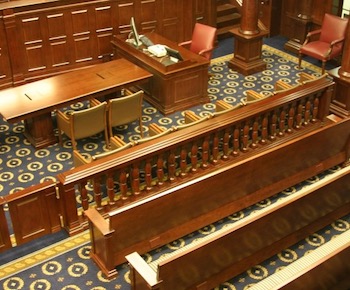“The CAFC found no error in the jury instructions, which defined the ordinary observer as ‘a person who buys and uses the product at issue’ and ‘correctly instructed [the jury] that the question is how the ordinary observer would view the article as a whole.’”
 The U.S. Court of Appeals for the Federal Circuit (CAFC) affirmed a decision of the District Court for the Southern District of West Virginia finding that GMS Mine Repair and Maintenance, Inc. (GMS) infringed Hafco Foundry and Machine Company, Inc.’s (Hafco) design patent, U.S. Design Patent No. D681,684 (the ’684 patent), directed to a rock dust blower for distributing rock dust in areas such as coal mines. The CAFC also affirmed the district court’s denial of GMS’ request for a new trial due to errors in the jury instructions.
The U.S. Court of Appeals for the Federal Circuit (CAFC) affirmed a decision of the District Court for the Southern District of West Virginia finding that GMS Mine Repair and Maintenance, Inc. (GMS) infringed Hafco Foundry and Machine Company, Inc.’s (Hafco) design patent, U.S. Design Patent No. D681,684 (the ’684 patent), directed to a rock dust blower for distributing rock dust in areas such as coal mines. The CAFC also affirmed the district court’s denial of GMS’ request for a new trial due to errors in the jury instructions.
A Short-Lived Agreement
Following the issuance of the ‘684 patent in 2013, Hafco entered into a contract with GMS whereby GMS served as a distributor of Hafco’s rock dust blower. The arrangement was short lived and was terminated by Hafco after only a year due to GMS’ alleged poor performance. GMS then began to produce and sell its own rock dust blower.
District Court Proceedings
Hafco filed an infringement suit against GMS and GMS responded with a pre-trial motion for invalidity of the ‘684 patent. The district court denied the motion, finding that GMS did not present any evidence to establish invalidity. Thus, the on a jury verdict finding GMS liable for willful infringement and awarding $123,650 in damages. Both Hafco and GMS filed post-trial motions. In response to Hafco’s motion, the court entered a permanent injunction against infringement. In response to GMS’ motion, the court remitted the damages award to zero and offered a new trial on damages, which was stayed pending the appeal to the CAFC. The district court also “ruled that substantial evidence supported the jury verdict of infringement, that the jury instructions were proper, and that it had not in fact precluded GMS from arguing invalidity at trial.”
Appeal to the CAFC
On appeal, GMS raised the issues of whether it was entitled to a judgment as a matter of law on the issue of infringement and whether it was entitled to a new trial due to errors of law in the jury instructions. GMS argued that if certain non-functional and prior art features of the ‘684 patent were excluded, then its rock dust blower would not infringe the claimed design. However, the CAFC responded that GMS did not preserve the non-infringement argument for appeal because it didn’t make the argument before the district court, nor did it present evidence on the non-functional or prior art aspects of the claimed design to the jury.
A Review of the Jury Instructions
With respect to whether it was entitled to a new trial due to errors of law in the jury instructions, GMS asserted that the “instructions ‘incompletely and prejudicially abridg[ed] the Gorham test,’ referring to Gorham Co. v. White, 81 U.S. 511, 528 (1871)” and the jury should have been instructed “that the hypothetical ordinary purchaser is to view the patented and accused designs ‘in the context of the prior art.’”
The CAFC first addressed the question of whether the district court correctly instructed the jury. The Court noted that “[i]nfringement of a design patent is determined from the viewpoint of the ordinary observer, comparing the patented design with the article’s overall appearance”, in accordance with Gorham. The CAFC found no error in the jury instructions, which defined the ordinary observer as “a person who buys and uses the product at issue” and “correctly instructed [the jury] that the question is how the ordinary observer would view the article as a whole.”
The Court also considered GMS’ argument that the jury was not properly instructed to consider the prior art when viewing the patented and accused designs. However, as noted by Hafco, GMS did not present any prior art for consideration by the jury, nor did GMS present a jury instruction regarding prior art. In concluding that the GMS did not demonstrate that a new trial was warranted, the CAFC noted that since “there was no prior art introduced at trial, no attempt by GMS to introduce the prior art, and no proposed jury instruction on this issue, the purported exclusion of this instruction cannot be error.”
Judge Newman’s Comments on Damages
Judge Newman concurred with the majority’s decision but wrote separately to note that she would have resolved the matter of damages by accepting Hafco’s proposed remitter of $110,000, which was the total of Hafco’s lost profits. Although properly instructed, the jury incorrectly awarded $123,650 in damages based on GMS’ infringing sales. The parties agreed that the correct standard was Hafco’s lost profits of $110,000, rather than GMS’ infringing sales. Newman would thus have corrected the district court’s judgment and remitted the damages award to the undisputed amount of $110,000.

![[IPWatchdog Logo]](https://ipwatchdog.com/wp-content/themes/IPWatchdog%20-%202023/assets/images/temp/logo-small@2x.png)

![[[Advertisement]]](https://ipwatchdog.com/wp-content/uploads/2024/04/Patent-Litigation-2024-banner-938x313-1.jpeg)
![[Advertisement]](https://ipwatchdog.com/wp-content/uploads/2024/04/UnitedLex-May-2-2024-sidebar-700x500-1.jpg)
![[Advertisement]](https://ipwatchdog.com/wp-content/uploads/2024/05/Quartz-IP-May-9-2024-sidebar-700x500-1.jpg)
![[Advertisement]](https://ipwatchdog.com/wp-content/uploads/2024/04/Patent-Litigation-Masters-2024-sidebar-700x500-1.jpg)

![[Advertisement]](https://ipwatchdog.com/wp-content/uploads/2021/12/WEBINAR-336-x-280-px.png)
![[Advertisement]](https://ipwatchdog.com/wp-content/uploads/2021/12/2021-Patent-Practice-on-Demand-recorded-Feb-2021-336-x-280.jpg)
![[Advertisement]](https://ipwatchdog.com/wp-content/uploads/2021/12/Ad-4-The-Invent-Patent-System™.png)







Join the Discussion
No comments yet.